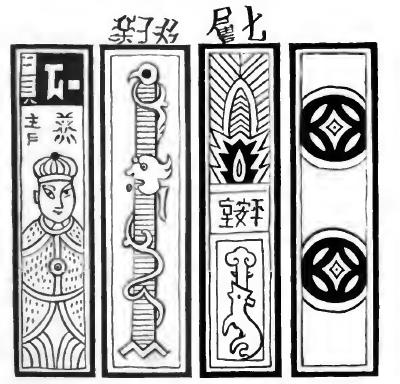
It is generally believed that the invention of playing cards took place in ancient China.
The type of deck considered to be the most ancient had a suit of coins, a suit of strings of coins, a suit of myriads (tens of thousands) of strings of coins, and a suit of tens of myriads of strings of coins.
Despite the nature of the suits, this didn't mean the suits had a rank outweighing that of the value of the cards, as one might naively think.
For a time, some cards from this type of deck bore pictures of characters from the popular novel Water Margin.
A picture of some Chinese cards from the Imperial Library in Paris that appeared in some books is shown below:

The tiles used to play Mah Jongg, a game somewhat like Gin Rummy, even more strongly resemble playing cards, but they came along much later.
Next, playing cards came to India. There, in addition to rectangular cards, round cards originated. Both types of cards were known as ganjifa.
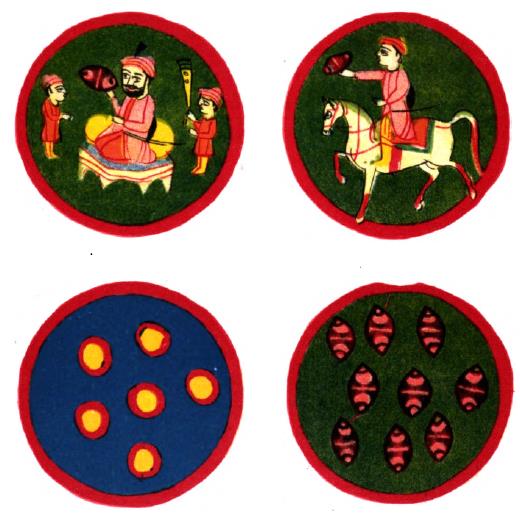
One type of deck contains 96 cards, in eight suits of twelve cards; pip cards from 1 to 10, and two court cards, the Vizier and the King. In four of the eight suits, the cards rank 10, 9... 2, 1, Vizier, King while in the other four, they rank, as one might expect, 1, 2... 9, 10, Vizier, King. And they are used to play a game somewhat like Whist.
Wikipedia cites a paper by Andrea Pollett for a hypothesis concerning the relationship between the Chinese card suits and those which eventually came to Europe from the Muslim world.
The suit of coins could have remained coins (diamonds); the suit of strings of coins could have become clubs or batons or wands (clubs); the suit of tens of strings of coins, since the Chinese character for ten looks like a plus sign (+), and so the cross-bar on that character could have been seen as the cross-guard on a sowrd, leading to the suit of swords (spades); and finally, since the Chinese character for ten thousand looks a bit like a lower-case letter h, upside down it could have been seen as a cup, leading to the suit of cups (hearts).
Tarot cards appear to have been entirely a European invention, following the introduction of playing cards to Europe through the Middle East.
Here are three of the twenty-two Tarot trumps in an old deck:
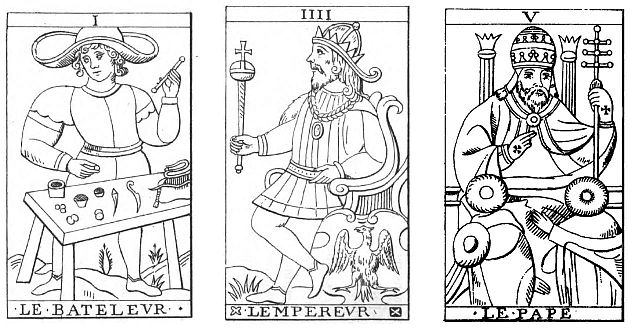
and here are the sevens of cups, swords, coins, and batons from the rest of the deck, which is otherwise a conventional Italian-suited deck, except for having both Knaves and Knights.
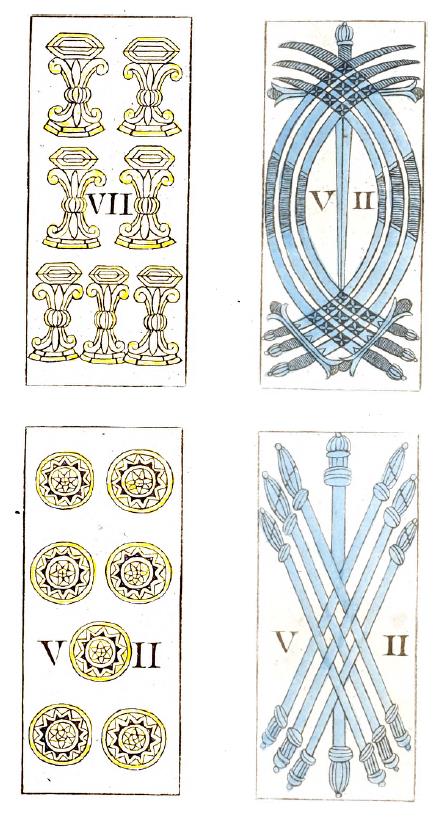
Italy, Spain, Germany, and France each developed their own distinctive style of symbols for the four suits.
The English-speaking world, of course, uses the French suit symbols. The origin of the traditional deck of cards used in the English-speaking world, however, can be established in more detail.
The different areas of France all had their own distinctive traditional styles of playing cards. English cards were based on those of Rouen, when an English playing card industry started in 1628, when the import of playing cards into Britain was banned.
In the Departmental Archives of the Lower Seine, a set of ten court cards from a deck by Pierre Maréchal dating from 1587 in this pattern are preserved; here is how they are pictured in an old book from 1906:
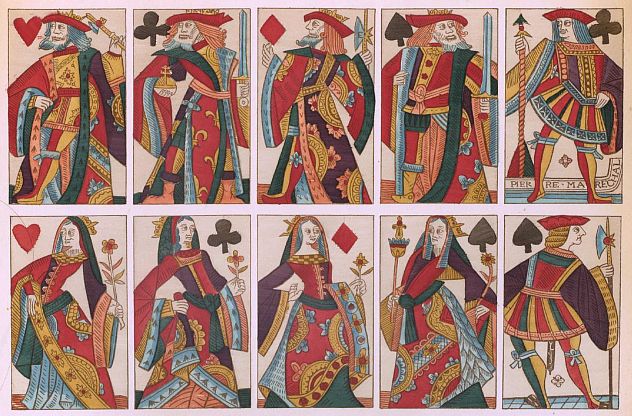
The most obvious indication of this is that in the Rouen deck, the King of Hearts had a small ax as his weapon. That became distorted in the English deck to a long sword which passed behind the King's head.
As cards are drawn in a two-dimensional style which makes it hard to distinguish "behind" from "through", the King of Hearts in the English deck acquired the colorful name of the "Suicide King".
But in other ways, the modern English deck of cards resembles these. The Kings of Clubs and Spades have swords held upright, while the King of Diamonds has a pike. All the Queens bear flowers; only the Queen of Spades also has a weapon.
Here is what the King of Clubs looks like in one old English deck:
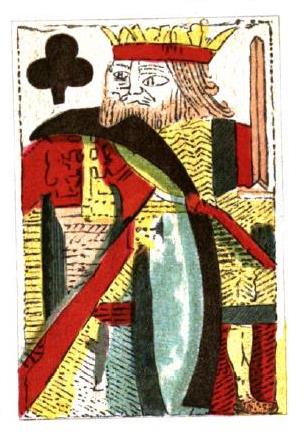
Because of the use of playing cards in gambling, card players tended to be very conservative about the designs of cards which they preferred. So change in how playing cards appeard was very gradual, but it still did take place.
The first major change is said to have generally taken place around 1830: court cards changing from being single-ended to double-ended. The first double-ended cards still had the old-fashioned crude woodblock-like appearance. However, these changes did not take place in a uniform fashion; here are some single-ended playing cards with an entirely modern style of drawing:
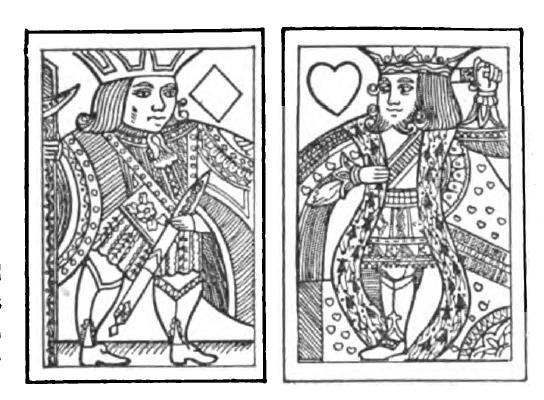
It was after cards became double-ended that the next innovation came along, placing indexes on the corners of cards.
Initially, three approaches to adding indexes to cards were tried, all in the 1870s.
One was to put the value of the card in reverse within the pip nearest the upper left (and lower right) corners of the card. This was first done in a deck called the "Dexter" by De La Rue. To make this work, some of the court cards needed to be modified; this usually was done by reflecting the whole card if its pips were normally on the upper right and lower left, but some decks using this system by other manufacturers simply redrew the cards, changing the proportions of some of the elements, to allow the pips to be moved instead.
However, the pips on the court cards seem to have been moved to the upper left (and possibly the lower right) even on single-ended cards, and by manufacturers of cards that never used this system of card indices, so that change seems to have also been driven by fashion, not just by the necessities of this index type.
Another way was to put little pictures of cards in the corners of a card. Cards like this were called "Triplicate" cards, and the most famous such cards were those by Dougherty, although some other card makers used this system as well.
The 1864 patent of C. W. Saladee, U. S. Patent 41,587, covered both conventional card indices and the triplicate form of cards.
The first deck of cards published according to that patent, by Samuel Hart in Philadelphia, was a single-ended deck, despite double-ended courts having been around for over a decade. The indices were quite small in size by modern standards, and the suit symbol was printed twice: to the right of the value of the card as well as below it.
Apparently, the next time card indexes appeared on a single-ended deck was in 1978, when TIME magazine made a reproduction of a single-ended deck as a promotional item, their "Independence Ball" deck! The anachronistic nature of this deck was disparaged here, although I rather think that it should have been applauded as a way of ensuring these reproductions wouldn't be used fraudulently as forgeries, a possibility decried on the same page which discusses reproductions of old decks of cards in general.
Despite triplicate cards being included in the Saladee patent, Andrew Dougherty obtained a patent for his Triplicate card design, and thus was able to enter into an agreement with the New York Consolidated Card Company by which the latter's cards with corner indices were sold only in the Eastern United States while Dougherty's Triplicate cards were sold only in the Western United States.
Andrew Dougherty is known for another innovation in playing cards that was a lasting success. In a deck specifically intended for the game of Euchre, in which the Jack of the trump suit is the Right Bower, and the Jack of the other suit of the same color as the trump suit is the Left Bower, he added a card, the Best Bower, which outranked both of those cards.
This card later became the Joker. This history is well-documented, and so even though, with the Joker being most often in the costume of a court jester, it did not descend from the Fool among the Tarot trumps, despite that card being used as an "Excuse" in some Tarocchi games. Or did it? After all, given that the Fool was used as an "Excuse" in existing Tarocchi games, couldn't the Fool have been precisely the inspiration for renaming and restyling the "Best Bower" into the modern-day Joker? So it could be that the Joker of today is descended from two predecessors rather than just one.
And, in fact, the motivation for doing it in this manner is obvious. On the one hand, the Joker is clearly related to the Fool in Tarots, which is pre-existing, and thus could be referenced should the originators of the Best Bower be feeling litigious - and, on the other hand, the new distinctive name of the Joker would still allow itself to be trademarked! (On the other hand, the name Joker is similar to the word Euchre, and even more so to the German name of that game, and thus the possibility of any relation to The Fool is often disputed.)
When a special wild card was first used for playing Poker, however, it was called the "Mistigris", a French word meaning "Kitten". However, this variation of Poker was originally played with the extra blank card some decks included as a potential substitute for a lost card, and then transitioned to using Jokers when decks had those instead; apparently, as far as I can determine, no decks were ever made with an extra card that was labelled as a Mistigris. Also, while decks today normally have two Jokers, the second Joker was apparently added specifically for the game of Canasta, and in some countries games are commonly played which require three Jokers, leading to three Jokers being included in decks.
One web site claimed that another type of Joker did appear in some European decks, for use with the game Nain Jaune ("Yellow Dwarf"). It showed examples of those Jokers, and each of them contained an image of a short person holding up the Seven of Diamonds. Other accounts of the game, however, describe the deck for it as containing only ordinary playing cards. The game is the direct ancestor of the English game of Pope Joan, and it belongs to the same family as Michigan Rummy and the German game of Poch.
From the diagram below
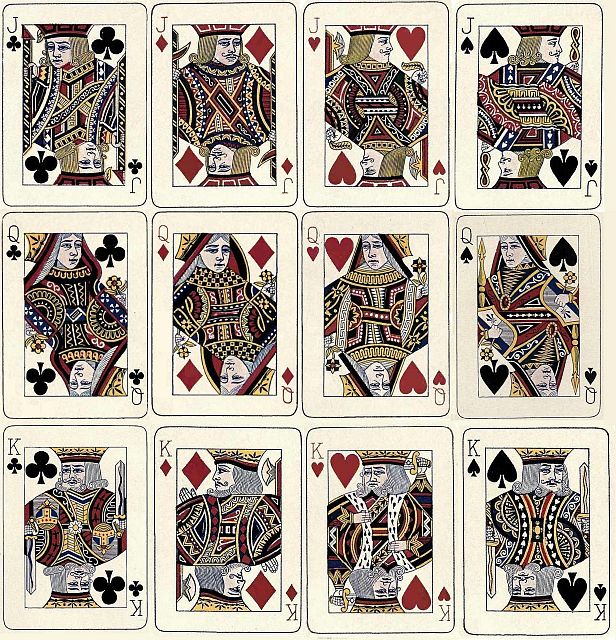
the various peculiarities in the modern deck of playing cards of the English pattern can be seen in all their glory.
The source of these images is a book printed in 1908, with the aim of showing that playing cards embody the wisdom encoded in the Great Pyramid, Nuggets from King Solomon's Mine by John Barnes Schmalz. The card designs are credited as being among those of the United States Playing Card Company, which, of course, despite having been recently bought by Cartamundi, is still making many popular brands of playing cards to this day.
This particular pattern of cards, however, is not normally used in any part of their current product line.
Note that while the pips on all the Kings are in the top left (and bottom right, the cards being double-headed) of the card, this is also true only of the Queen of Hearts and the Jack of Spaces, and not of any other Jacks or Queens. This is the traditional orientation of cards, even though it is not often seen these days.
From this, it can be seen that it is the Jack of Hearts and the Jack of Spades that correspond to the term "one-eyed Jacks", facing directly to the side of the card so that only one of their eyes is visible.
And the King of Diamonds is also one-eyed.
These characteristics are usually constant, although the details of the costumes in the court cards vary considerably from one manufacturer to another.
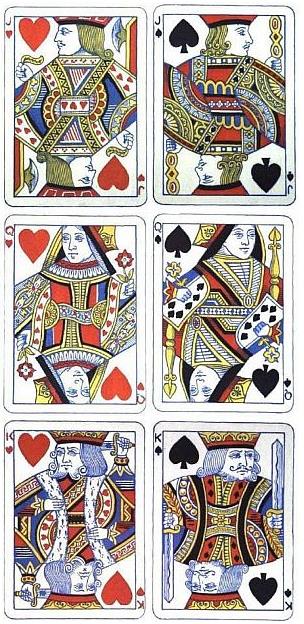
Thus, for comparison, from another book, one on the history of playing cards, published in French in 1906, here are the court cards from the suits of Hearts and Spades from another manufacturer for comparison, on the right.
These cards are from a deck made by a British manufacturer of playing cards, Goodall. At one time, they were Britain's largest makers of playing cards. Eventually, they were bought by De La Rue, and this card artwork was no longer used.
Note that here, the pips on the top side of the card are all on the left side, in the uniform fashion now common.
Thus, while in detail, the costumes of the two Jacks of Hearts are completely different, both of them are holding a leaf in the hand underneath the pip; this is the type of small detail that has been conserved in playing cards in order that they will be accepted by serious card players.
Above, we saw images of an early Tarot deck. Tarot cards developed in multiple ways from that.
Some Tarot decks were designed to show characters in Egyptian dress, or to exhibit symbolism derived from Kabbalism, or otherwise to serve better for use in fortune-telling.
Others were designed specifically for use as playing cards, deliberately avoiding association with the occult.
Thus, here is a Tarot card
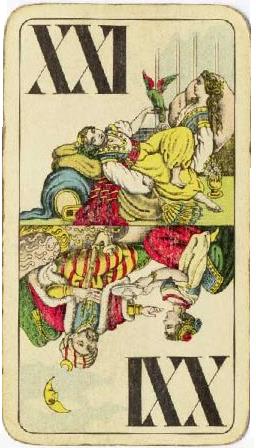
designed in the style known as Industrie und Glück, literally "Industry and Happiness"; perhaps a more idiomatic way to render this name in English would be "Work and Play".

The standard size for a sheet of writing paper in the English-speaking world was 8 1/2 by 11 inches before most English-speaking countries adopted the metric system. 11/8.5 is 1.294..., which, admittedly, is not a particularly close approximation to the square root of two (1.4142...).
However, it is indeed the case that the size of the pages of books, and the size of poker size playing cards, tends to be an approximation to the square root of two.
There is an obvious reason for this.
As can be seen from the diagram at left, you can choose any aspect ratio of a rectangle you wish, and, without waste, cut it up into any square number of rectangles of similar shape.
As can be seen from the diagram below, if one chooses a rectangle with sides in the ratio of one to the square root of two, one gains the additional flexibility that comes from being able to divide such a rectangle, along its longer side, into two halves that are also similar in shape.
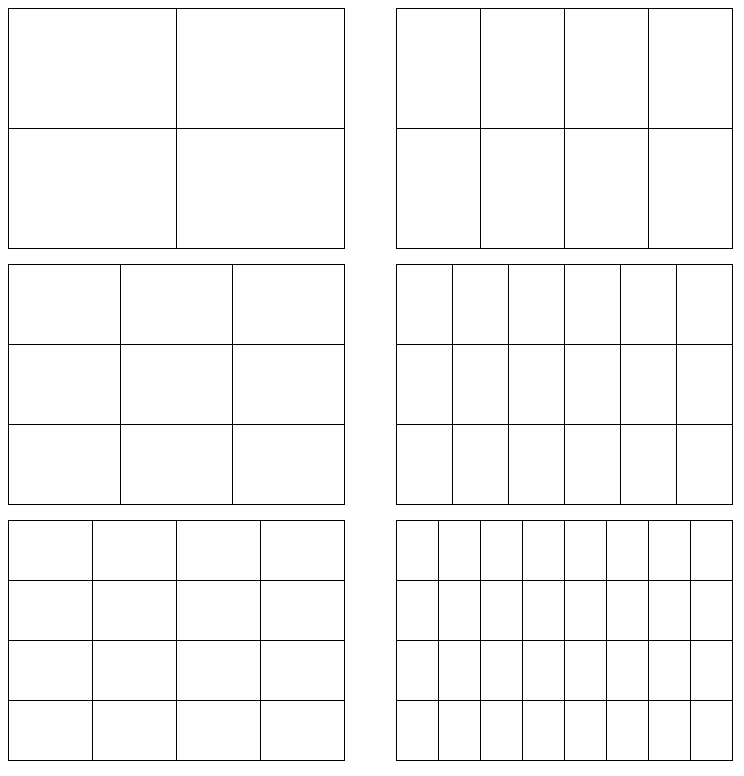
The diagram illustrates the printer's sizes of quarto and octavo in the first row, and sextodecimo and tricesimo-secundo in the third row.
In the second row, octodecimo is illustrated on the right side. I presume it would be nonavo that is illustrated on the left, but that size does not seem to have been used. Using the entire sheet for a page is called "plano", which is a rare size; folding it in half leads to the size known as folio, generally used for the largest books seen in practice, such as atlases.
In practice, of course, one would use a close rational approximation to the square root of two as the ratio between the sides, and merely get rectangles of nearly the same shape in that case.
This is all very well. But Bridge size playing cards, and Tarot size playing cards, have shapes which, instead, closely approximate to the golden ratio, which is about 1.618..., and which has a different property than the ratio of the square root of two, one not directly useful for printing: a rectangle of this aspect ratio can be folded into two parts as well, but only one has the same shape, but is smaller; the other part is a square.
Books are sometimes printed with pages in duodecimo size, folding the sheet three times one way, and four times the other way. This does change the aspect ratio of the page; the long size is lengthened by a factor of 4/3. This gives a ratio of 1.8856..., however, which is far from a good approximation to the golden ratio.
The duodecimo, vicesimo-quarto, and quadragesimo-octavo formats are illustrated in the diagram below:
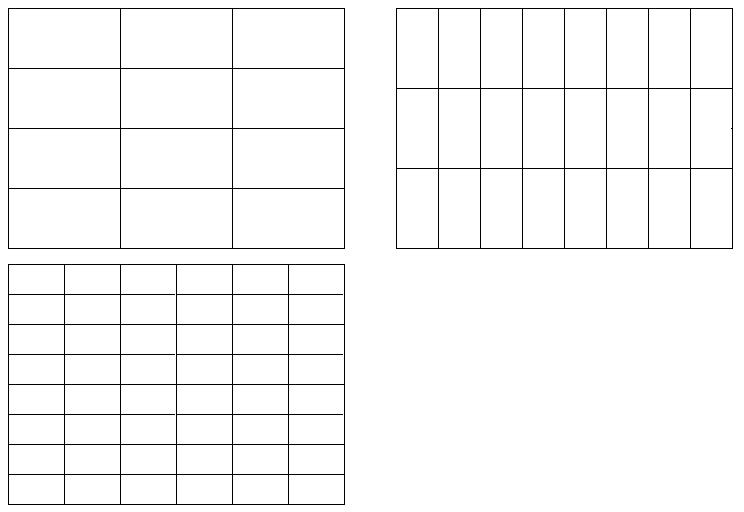
However, all is not lost. After all, playing cards are smaller than the pages of books, and so one has more choices.
As it happens, if one multiplies the square root of two by 1 1/7, one does get a close approximation to the golden ratio, 1.616... instead of 1.618..., and so if one can replace folding the sheet up into eight (or sixteen) parts along the long axis to seven (or fourteen) parts, the goal of approximating the golden ratio is achieved.

And so the problem is solved? Ah, but not so fast:
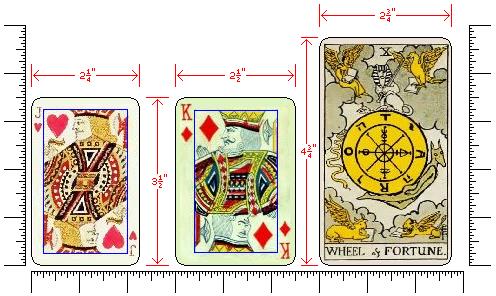
A Bridge size card is the same height as a Poker size card, but is narrower in width. The ratio of the two widths happens to be as 9 to 10, rather than 7 to 8, so the approximation to the golden ratio is presumably not as close. If the sheets of cardboard used for making playing cards were of a different size, perhaps a ratio of 8 to 9 could have been used, making for a closer approximation.
Incidentally, while today Bridge size cards are 2 1/4 by 3 1/2 inches, as opposed to 2 1/2 by 3 1/2 inches for Poker size cards, I have found an advertisement in a book from 1915 by the U. S. Playing Card Company that notes that U. S. Whist size cards are instead 2 3/8 by 3 1/2 inches, thus beiong narrower than Poker size cards by only half as much as modern Bridge size cards are.
Also, in addition to adding the U. S. Whist size to the Standard size and the French size, the modern Poker and Bridge sizes, they also made cards in a Petite size, 2 1/4 inches wide, and 3 1/4 inches high.
And in addition, at that time, they also made cards of a fifth size, for Pinochle: these cards were 2 1/4 inches wide, but they were also 3 3/4 inches tall; cards of that size were also made for playing Bridge. (These were the No. 93 Ivory Bridge cards, and the Mo. 930 Ivory Pinochle/Double Skat cards.)
Cards of the modern Bridge size were also made, both for Pinochle and for Bridge, and this size of cards was referred to as the French size. The Poker size was then called the Standard size.
Incidentally, a Pinochle deck does not contain the same 52 cards as a normal deck of cards; rather, it is played with a deck of 48 cards, being two 24-card decks containing the Ace, 9, 10, Jack, Queen and King of each suit. Bezique is also played with a similar special deck of 64 cards, being two 32-card decks containing the Ace, 7, 8, 9, 10, Jack, Queen, and King of each suit.
How would they have coped with so many different sizes of cards? Probably without not too much difficulty.
One modern playing card manufacturer uses rolls of card stock that are nominally 38 1/2 inches wide. This is eleven times the height of a normal playing card of 3 1/2 inches, whether Poker size or Bridge size. So if these may be laid end to end, the same would be true of a U. S. Whist size card, 2 3/8" in width and still 3 1/2" in height.
That width is also fourteen times the width of a Tarot size card, at 2 3/4" wide and 4 3/4" high, so they too are easily printed.
Miniature Tarot cards which are 1 3/4" by 2 7/8", also present no problem, since their width is half the size of a standard playing card, so 22 of them fit across on the available card stock.
But giant-size Tarot cards which are 4 inches wide and 6 1/2 inches tall do present a bit of a problem. They can be placed, on this size of card stock, with eight cards upright across, plus one card lying down. So one can cut the card stock into sheets where the upright cards come out even, and there is a little wasted space in the column of cards lying down.
So now we're prepared to face the question of cards that are 2 1/4 inches wide, but 3 3/4 inches high. As this card's size is a multiple of 3/4 inch in both directions, fitting together cards standing up and lying down will not be able to achieve a nominal width of 38 1/2 inches, as that is not a multiple of 3/4 inch. So, back then, no doubt they printed cards differently, and this explains why that particular size of cards is not printed any longer. However, we just have to waste a narrow 1/4" strip of card stock; the width will then fit seventeen cards standing upright.
At least the Petite size does not create this problem. Seven cards standing up vertically, and seven cards lying down, together fit the width of a roll. And nine cards standing up are as high as thirteen cards lying down, so sheets of 154 cards may be printed with no waste.
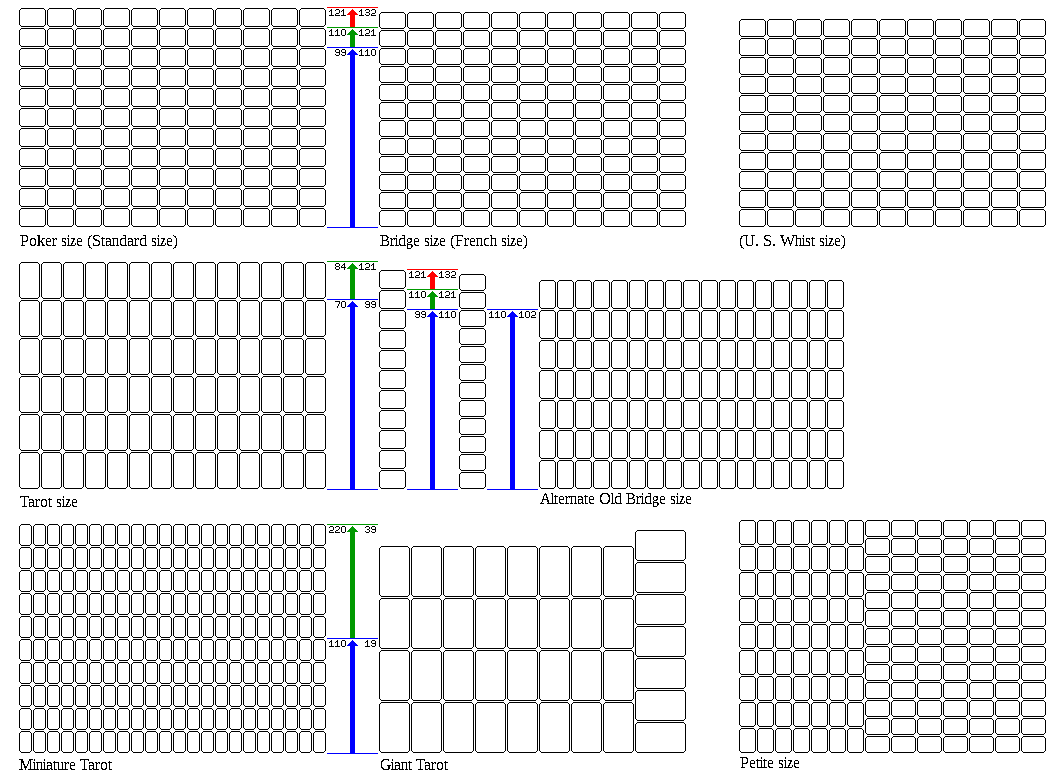
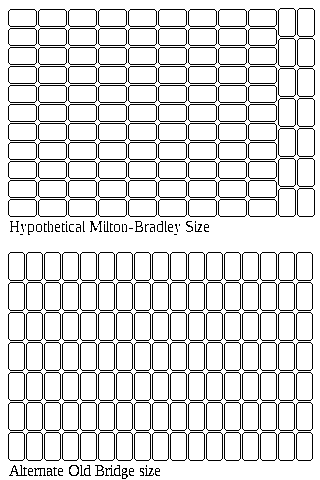
Of course, there are many other possible sizes for playing cards. Thus, Milton Bradley appears to have offered, with the game Charles Goren's Bridge for Two (and possibly some other games) special playing cards for Bridge that appear to have been particularly narrow in shape.
I don't know what size they were, but one possible size they might have had would have been 2 3/8" wide and 3 3/4" high. This would have been the same height as the Pinochle and Bridge cards noted above, but slighly wider, thus avoiding the problem that prevented a combination of cards standing up and lying down from matching the width of the card stock at 38 1/2 inches. Of course, even with the dimensions being relatively prime multiples of one-eighth of an inch, there is no guarantee that a solution will be available. But indeed there is a simple solution: nine cards lying down, followed by two cards standing up. A diagram illustrating this is shown at right.
One could print a sheet containing 82 cards of this size with minimal wastage, only a small amount of cardboard above the two columns of cards standing up. If one such sheet contained the first 41 cards of two decks, then, assuming a deck size of 55 cards, the remaining 14 cards could be repeated five times over on another such sheet, leaving 12 extra cards. So those 12 could be an incomplete set of 14 cards, with a third sheet just repeating the two missing cards over and over, so with three sheet types, avoiding any additional wastage would be achieved.
Incidentally, cards for playing Skat have a special size, 59 mm by 91 mm. In inches, that works out to 2.32" by 3.58", which would be approximately 2 5/16" (2.3125") by 3 9/16" (3.5625"). As that is very close to Bridge size, presumably U. S. playing card manufacturers would not attempt to match this size. However, if one supposes instead that it is attempted to make cards that are 2 3/8" by 3 5/8" in size, how would these be organized?
The answer is in eight columns of cards lying down, and four columns of cards standing up, as shown in the diagram below:

which also points out the interesting coincidence that the 2 3/8" width of these cards, and of the old U. S. Whist size of cards, is half the height of a Tarot-sized card.
Copyright (c) 2023 John J. G. Savard